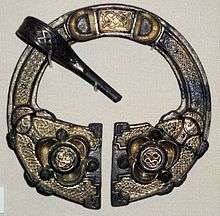Breadalbane Brooch
|
| |
| Material | Silver, gilding, gold, glass |
|---|---|
| Size | Diameter 9.8 cm; Weight 140.8 grams |
| Created | 8th Century |
| Place | Ireland, Scotland (pin) |
| Present location | British Museum |
| Identification | 1919,1218.1 |
Description
The brooch and pin were cast in silver with exquisite geometric and zoomorphic interlace patterns and inset with three green-glass cabochon gems (one of which is missing). Several moulded sections were used, although the main ring was cast in one piece, other goldsmith's techniques were used in the decoration. both front and back were partially gilded, with gold and gold foil also used in parts of the decoration. There may have been inset pieces of amber, which are now missing. There is decoration on both front and back, in rather different styles, a feature also found in the Tara Brooch and Hunterston Brooch.[2]

This is one of a number of brooches which were made in the Irish "pseudo-penannular" style, with the ring fully closed (like the two just mentioned and the Londesborough Brooch), but later adapted to a true penannular brooch by cutting away the bridging section linking the large terminals.[3] The pin, which moves freely around the ring between the terminals (see other picture), is broken but would have originally extended to at least double the brooch's diameter. It appears to be a replacement, made in Scotland, probably at the same time that the form of the ring was adapted, by cutting the bridge to make the brooch truly penannular.[4]
History of ownership
The design and manufacture of the brooch mixes Celtic and Pictish styles - it may originally have been a gift from an Irish dignitary to his Scottish counterpart, who later repaired or embellished the brooch according to local tastes. The original provenance of the brooch is unknown, although it is conjectured that the brooch was found in Perthshire in Scotland as it was probably first owned by Gavin Campbell, 1st Marquess of Breadalbane, whose country estate was located in that county. The brooch was later donated to the national collection by Sir John Ramsden, following the sale of the Breadalbane Collection in 1917.[5]
Notes
References
- Susan Youngs (ed), "The Work of Angels", Masterpieces of Celtic Metalwork, 6th–9th centuries AD, cat. # 72, 1989, British Museum Press, London, ISBN 0714105546, the catalogue entry text quoted on the BM website (click "more" on linked page)
Further reading
- P. Harbison, The golden age of Irish art (London, Thames and Hudson, 1999)